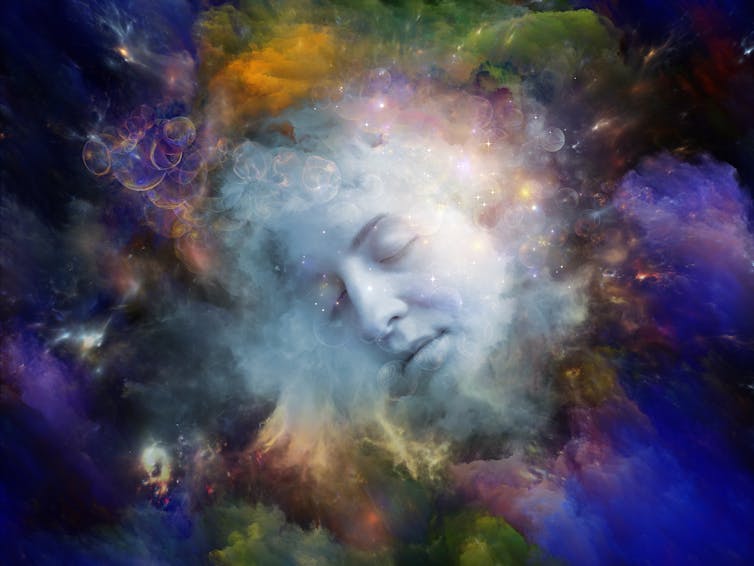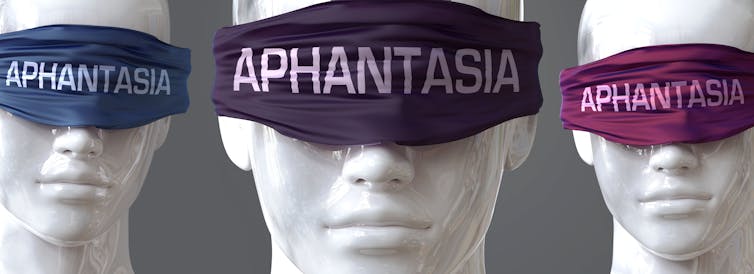Pseudo-hallucinations: why some people see more vivid mental images than others – test yourself here
Author: Reshanne Reeder, Senior Lecturer in Psychology, Edge Hill University

Consider the statements below. What do they describe? A trip on psychedelics? A dream?
I felt I could reach through the screen to get to another place.
Lasers became entire fans of light sweeping around, and then it felt as if the screen began to expand.
I saw old stone buildings … like a castle … I was flying above it.
In reality, they are statements that different people reported after viewing the “Ganzflicker” on their computers – an intense full-screen, red-and-black flicker that anyone can access online and that we use in our experiments. In less than ten minutes, it creates altered states of consciousness, with no lasting effects for the brain. Visual experiences set in almost as soon as you start looking at it.
But our new study, published in Cortex, shows that while some people see castles or fractals in the Ganzflicker, others see nothing. We have come up with a theory of where those individual differences come from.
Like a computer screen, the part of your brain that processes visual information (the visual cortex) has a refresh “button” which helps it sample the environment – taking snapshots of the world in quick succession. In other words, your brain collects sensory information with a certain frequency. Yet you see the world as continuous and dynamic, thanks to your brain’s sophisticated ability to fill in the blanks.
For example, your eyes have a blind spot right outside the centre of vision, but you don’t see a patch of blackness everywhere you look. Your visual cortex extrapolates from the surrounding visual information so that your whole field of view appears to be complete. If the sensory information being processed is the Ganzflicker, this will interact with your brain’s own rhythms to alter how you fill in or interpret what you are seeing.
Ganzflicker is known to elicit the experience of anomalous sensory information in the external environment, called pseudo-hallucinations. “Simple” experiences – like seeing lasers or illusory colours – have previously been explained as your brain reacting to clashes between Ganzflicker and the brain’s rhythms. But how do some people see complex pseudo-hallucinations such as “old stone castles”?
Capacity for mental images
The brain is composed of many different regions interacting with each other, including “low-level” sensory regions and regions that correspond to “high-level” cognitive processes. Discriminating whether a line is vertical or horizontal, for example, is considered a low-level sensory process, whereas determining whether a face is friendly or annoyed is a high-level cognitive process. The latter is more open to interpretation.
Visual mental imagery, or the mental simulation of sensory information – the “mind’s eye” – is one of these high-level cognitive processes. High-level processes can interact with low-level processes to shape your brain’s interpretation of what you are seeing. If someone sees simple pseudo-hallucinations in the Ganzflicker, their brains may automatically interpret that information as more meaningful or realistic with help from their mind’s eye.

GoodIdeas/Shutterstock
What most people don’t realise is that everyone’s imagery is different. Some people have imagery that is as vivid as actually seeing something in front of them. A small proportion of people have a “blind mind’s eye” and cannot even visualise the faces of their friends or family. This condition is called aphantasia, and has attracted an increasing amount of attention in the last few years. Many people are, of course, somewhere in between these extremes.
The power of Ganzflicker
It is very difficult to describe and compare imagery experiences, since they are private, internal, subjective events. But it turns out that the Ganzflicker can help.
We discovered that imagery ability can be reflected in an individual’s description of a ten-minute experience with Ganzflicker. Almost half of people with aphantasia see absolutely nothing in the Ganzflicker. The other half see mostly simple patterns like geometric shapes or illusory colours. Compare that to people with visual mental imagery, for whom the majority see meaningful complex objects, such as animals and faces. Some even see entire pseudo-hallucinatory environments, like a stormy beach or a medieval castle.
Going back to the idea of brain rhythms, it’s possible that people who see imagery have naturally lower-frequency rhythms in visual cortex – closer to the Ganzflicker frequency – which makes them susceptible to experiencing pseudo-hallucinations. People with aphantasia, on the other hand, have naturally higher-frequency rhythms in the visual cortex – which may give them a buffer against the effects of the Ganzflicker.
Our theory is that mental imagery and pseudo-hallucinations elicited by Ganzflicker are tapping into the same processes in the brain. This means that Ganzflicker captures a dynamic projection of people’s imagined experiences, like opening a window to the mind’s eye.
Ganzflicker is therefore a promising tool for understanding individual differences in mental imagery and its interaction with the visual environment.
The experiment can help people share their unique experiences with each other – ultimately bringing subjective experience into the real world.![]()
This article is republished from The Conversation under a Creative Commons license. Original article.